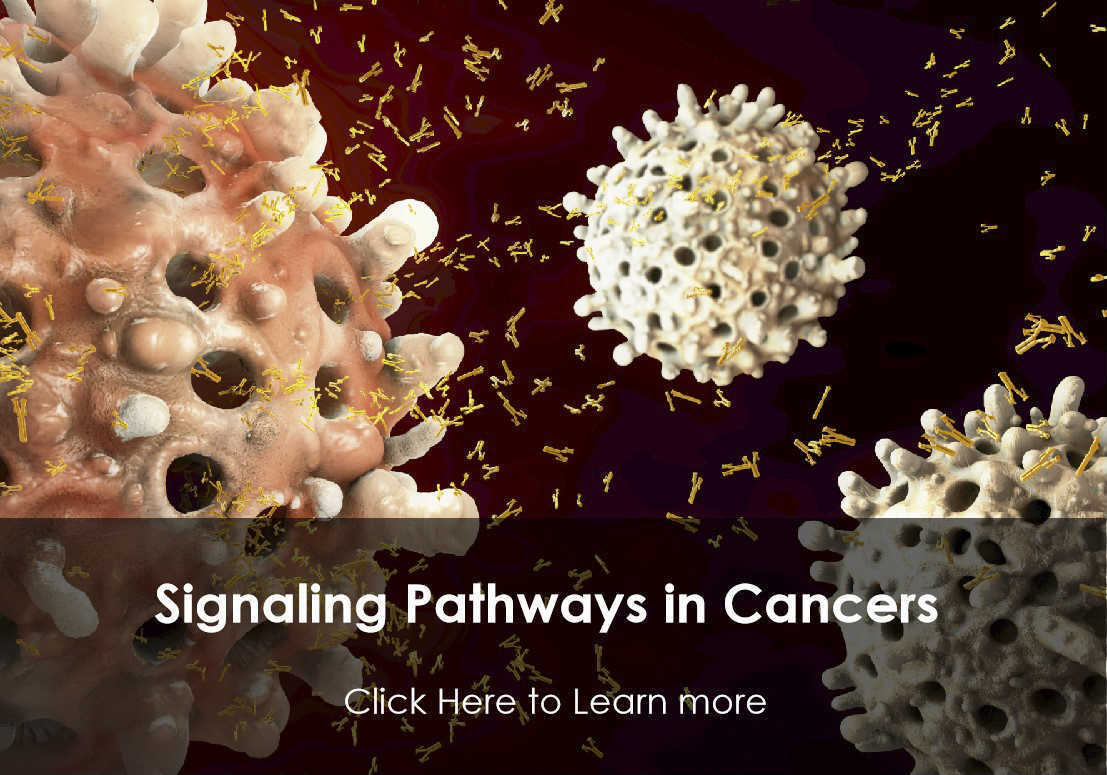RAD51
The protein encoded by this gene is a member of the RAD51 protein family. RAD51 family members are highly similar to bacterial RecA and Saccharomyces cerevisiae Rad51, and are known to be involved in the homologous recombination and repair of DNA. This protein can interact with the ssDNA-binding protein RPA and RAD52, and it is thought to play roles in homologous pairing and strand transfer of DNA. This protein is also found to interact with BRCA1 and BRCA2, which may be important for the cellular response to DNA damage. BRCA2 is shown to regulate both the intracellular localization and DNA-binding ability of this protein. Loss of these controls following BRCA2 inactivation may be a key event leading to genomic instability and tumorigenesis. Multiple transcript variants encoding different isoforms have been found for this gene. [provided by RefSeq, Aug 2009]
Full Name
RAD51 Recombinase
Function
Plays an important role in homologous strand exchange, a key step in DNA repair through homologous recombination (HR) (PubMed:18417535, PubMed:20348101, PubMed:12205100, PubMed:20231364, PubMed:23754376, PubMed:23509288, PubMed:28575658, PubMed:26681308).
Binds to single-stranded DNA in an ATP-dependent manner to form nucleoprotein filaments which are essential for the homology search and strand exchange (PubMed:18417535, PubMed:20348101, PubMed:12205100, PubMed:20231364, PubMed:23754376, PubMed:23509288, PubMed:28575658, PubMed:26681308).
Catalyzes the recognition of homology and strand exchange between homologous DNA partners to form a joint molecule between a processed DNA break and the repair template (PubMed:18417535, PubMed:20348101, PubMed:12205100, PubMed:20231364, PubMed:23754376, PubMed:23509288, PubMed:28575658, PubMed:26681308).
Recruited to resolve stalled replication forks during replication stress (PubMed:27797818, PubMed:31844045).
Part of a PALB2-scaffolded HR complex containing BRCA2 and RAD51C and which is thought to play a role in DNA repair by HR (PubMed:24141787, PubMed:12442171).
Plays a role in regulating mitochondrial DNA copy number under conditions of oxidative stress in the presence of RAD51C and XRCC3 (PubMed:20413593).
Also involved in interstrand cross-link repair (PubMed:26253028).
Binds to single-stranded DNA in an ATP-dependent manner to form nucleoprotein filaments which are essential for the homology search and strand exchange (PubMed:18417535, PubMed:20348101, PubMed:12205100, PubMed:20231364, PubMed:23754376, PubMed:23509288, PubMed:28575658, PubMed:26681308).
Catalyzes the recognition of homology and strand exchange between homologous DNA partners to form a joint molecule between a processed DNA break and the repair template (PubMed:18417535, PubMed:20348101, PubMed:12205100, PubMed:20231364, PubMed:23754376, PubMed:23509288, PubMed:28575658, PubMed:26681308).
Recruited to resolve stalled replication forks during replication stress (PubMed:27797818, PubMed:31844045).
Part of a PALB2-scaffolded HR complex containing BRCA2 and RAD51C and which is thought to play a role in DNA repair by HR (PubMed:24141787, PubMed:12442171).
Plays a role in regulating mitochondrial DNA copy number under conditions of oxidative stress in the presence of RAD51C and XRCC3 (PubMed:20413593).
Also involved in interstrand cross-link repair (PubMed:26253028).
Biological Process
Biological Process cellular response to camptothecinManual Assertion Based On ExperimentIDA:UniProtKB
Biological Process cellular response to cisplatinIEA:Ensembl
Biological Process cellular response to DNA damage stimulusManual Assertion Based On ExperimentIDA:UniProtKB
Biological Process cellular response to gamma radiationIEA:Ensembl
Biological Process cellular response to hydroxyureaIEA:Ensembl
Biological Process cellular response to ionizing radiationManual Assertion Based On ExperimentIDA:UniProtKB
Biological Process chromosome organization involved in meiotic cell cycleManual Assertion Based On ExperimentIBA:GO_Central
Biological Process DNA recombinase assemblyManual Assertion Based On ExperimentIMP:UniProtKB
Biological Process DNA recombinationManual Assertion Based On ExperimentTAS:UniProtKB
Biological Process DNA repairManual Assertion Based On ExperimentTAS:ProtInc
Biological Process DNA unwinding involved in DNA replicationManual Assertion Based On ExperimentIDA:UniProtKB
Biological Process double-strand break repair via homologous recombinationManual Assertion Based On ExperimentIDA:UniProtKB
Biological Process histone H2A monoubiquitination1 PublicationIC:ComplexPortal
Biological Process interstrand cross-link repairManual Assertion Based On ExperimentIMP:UniProtKB
Biological Process meiotic cell cycleISS:UniProtKB
Biological Process mitotic recombinationManual Assertion Based On ExperimentIBA:GO_Central
Biological Process mitotic recombination-dependent replication fork processingIEA:InterPro
Biological Process positive regulation of DNA ligationManual Assertion Based On ExperimentIDA:UniProtKB
Biological Process protein autoubiquitination1 PublicationIC:ComplexPortal
Biological Process reciprocal meiotic recombinationManual Assertion Based On ExperimentIBA:GO_Central
Biological Process regulation of DNA damage checkpoint1 PublicationIC:ComplexPortal
Biological Process regulation of double-strand break repair via homologous recombinationManual Assertion Based On ExperimentIDA:UniProtKB
Biological Process regulation of protein phosphorylationIEA:Ensembl
Biological Process replication fork processingManual Assertion Based On ExperimentIDA:UniProtKB
Biological Process replication-born double-strand break repair via sister chromatid exchangeIEA:Ensembl
Biological Process response to glucosideIEA:Ensembl
Biological Process response to toxic substanceIEA:Ensembl
Biological Process response to X-rayIEA:Ensembl
Biological Process response to xenobiotic stimulusIEA:Ensembl
Biological Process strand invasionManual Assertion Based On ExperimentIBA:GO_Central
Biological Process telomere maintenance via recombinationBy SimilarityISS:BHF-UCL
Biological Process telomere maintenance via telomere lengtheningBy SimilarityISS:BHF-UCL
Biological Process cellular response to cisplatinIEA:Ensembl
Biological Process cellular response to DNA damage stimulusManual Assertion Based On ExperimentIDA:UniProtKB
Biological Process cellular response to gamma radiationIEA:Ensembl
Biological Process cellular response to hydroxyureaIEA:Ensembl
Biological Process cellular response to ionizing radiationManual Assertion Based On ExperimentIDA:UniProtKB
Biological Process chromosome organization involved in meiotic cell cycleManual Assertion Based On ExperimentIBA:GO_Central
Biological Process DNA recombinase assemblyManual Assertion Based On ExperimentIMP:UniProtKB
Biological Process DNA recombinationManual Assertion Based On ExperimentTAS:UniProtKB
Biological Process DNA repairManual Assertion Based On ExperimentTAS:ProtInc
Biological Process DNA unwinding involved in DNA replicationManual Assertion Based On ExperimentIDA:UniProtKB
Biological Process double-strand break repair via homologous recombinationManual Assertion Based On ExperimentIDA:UniProtKB
Biological Process histone H2A monoubiquitination1 PublicationIC:ComplexPortal
Biological Process interstrand cross-link repairManual Assertion Based On ExperimentIMP:UniProtKB
Biological Process meiotic cell cycleISS:UniProtKB
Biological Process mitotic recombinationManual Assertion Based On ExperimentIBA:GO_Central
Biological Process mitotic recombination-dependent replication fork processingIEA:InterPro
Biological Process positive regulation of DNA ligationManual Assertion Based On ExperimentIDA:UniProtKB
Biological Process protein autoubiquitination1 PublicationIC:ComplexPortal
Biological Process reciprocal meiotic recombinationManual Assertion Based On ExperimentIBA:GO_Central
Biological Process regulation of DNA damage checkpoint1 PublicationIC:ComplexPortal
Biological Process regulation of double-strand break repair via homologous recombinationManual Assertion Based On ExperimentIDA:UniProtKB
Biological Process regulation of protein phosphorylationIEA:Ensembl
Biological Process replication fork processingManual Assertion Based On ExperimentIDA:UniProtKB
Biological Process replication-born double-strand break repair via sister chromatid exchangeIEA:Ensembl
Biological Process response to glucosideIEA:Ensembl
Biological Process response to toxic substanceIEA:Ensembl
Biological Process response to X-rayIEA:Ensembl
Biological Process response to xenobiotic stimulusIEA:Ensembl
Biological Process strand invasionManual Assertion Based On ExperimentIBA:GO_Central
Biological Process telomere maintenance via recombinationBy SimilarityISS:BHF-UCL
Biological Process telomere maintenance via telomere lengtheningBy SimilarityISS:BHF-UCL
Cellular Location
Nucleus
Cytoplasm
Cytoplasm, perinuclear region
Mitochondrion matrix
Chromosome
Cytoplasm, cytoskeleton, microtubule organizing center, centrosome
Colocalizes with RAD51AP1 and RPA2 to multiple nuclear foci upon induction of DNA damage (PubMed:20154705).
DNA damage induces an increase in nuclear levels (PubMed:20154705).
Together with FIGNL1, redistributed in discrete nuclear DNA damage-induced foci after ionizing radiation (IR) or camptothecin (CPT) treatment (PubMed:23754376).
Accumulated at sites of DNA damage in a SPIDR-dependent manner (PubMed:23509288).
Recruited at sites of DNA damage in a MCM9-MCM8-dependent manner (PubMed:23401855).
Colocalizes with ERCC5/XPG to nuclear foci in S phase (PubMed:26833090).
Recruited to stalled replication forks during replication stress by the TONSL-MMS22L complex, as well as ATAD5 and WDR48 in an ATR-dependent manner (PubMed:27797818, PubMed:31844045).
Cytoplasm
Cytoplasm, perinuclear region
Mitochondrion matrix
Chromosome
Cytoplasm, cytoskeleton, microtubule organizing center, centrosome
Colocalizes with RAD51AP1 and RPA2 to multiple nuclear foci upon induction of DNA damage (PubMed:20154705).
DNA damage induces an increase in nuclear levels (PubMed:20154705).
Together with FIGNL1, redistributed in discrete nuclear DNA damage-induced foci after ionizing radiation (IR) or camptothecin (CPT) treatment (PubMed:23754376).
Accumulated at sites of DNA damage in a SPIDR-dependent manner (PubMed:23509288).
Recruited at sites of DNA damage in a MCM9-MCM8-dependent manner (PubMed:23401855).
Colocalizes with ERCC5/XPG to nuclear foci in S phase (PubMed:26833090).
Recruited to stalled replication forks during replication stress by the TONSL-MMS22L complex, as well as ATAD5 and WDR48 in an ATR-dependent manner (PubMed:27797818, PubMed:31844045).
Involvement in disease
Breast cancer (BC):
A common malignancy originating from breast epithelial tissue. Breast neoplasms can be distinguished by their histologic pattern. Invasive ductal carcinoma is by far the most common type. Breast cancer is etiologically and genetically heterogeneous. Important genetic factors have been indicated by familial occurrence and bilateral involvement. Mutations at more than one locus can be involved in different families or even in the same case.
Mirror movements 2 (MRMV2):
A disorder characterized by contralateral involuntary movements that mirror voluntary ones. While mirror movements are occasionally found in young children, persistence beyond the age of 10 is abnormal. Mirror movements occur more commonly in the upper extremities.
Fanconi anemia, complementation group R (FANCR):
A disorder affecting all bone marrow elements and resulting in anemia, leukopenia and thrombopenia. It is associated with cardiac, renal and limb malformations, dermal pigmentary changes, and a predisposition to the development of malignancies. At the cellular level it is associated with hypersensitivity to DNA-damaging agents, chromosomal instability (increased chromosome breakage) and defective DNA repair.
A common malignancy originating from breast epithelial tissue. Breast neoplasms can be distinguished by their histologic pattern. Invasive ductal carcinoma is by far the most common type. Breast cancer is etiologically and genetically heterogeneous. Important genetic factors have been indicated by familial occurrence and bilateral involvement. Mutations at more than one locus can be involved in different families or even in the same case.
Mirror movements 2 (MRMV2):
A disorder characterized by contralateral involuntary movements that mirror voluntary ones. While mirror movements are occasionally found in young children, persistence beyond the age of 10 is abnormal. Mirror movements occur more commonly in the upper extremities.
Fanconi anemia, complementation group R (FANCR):
A disorder affecting all bone marrow elements and resulting in anemia, leukopenia and thrombopenia. It is associated with cardiac, renal and limb malformations, dermal pigmentary changes, and a predisposition to the development of malignancies. At the cellular level it is associated with hypersensitivity to DNA-damaging agents, chromosomal instability (increased chromosome breakage) and defective DNA repair.
PTM
Ubiquitinated by the SCF(FBH1) E3 ubiquitin ligase complex, regulating RAD51 subcellular location and preventing its association with DNA. Ubiquitinated by RFWD3 in response to DNA damage: ubiquitination leads to degradation by the proteasome, promoting homologous recombination (PubMed:28575658).
Phosphorylated. Phosphorylation of Thr-309 by CHEK1 may enhance association with chromatin at sites of DNA damage and promote DNA repair by homologous recombination. Phosphorylation by ABL1 inhibits function.
Phosphorylated. Phosphorylation of Thr-309 by CHEK1 may enhance association with chromatin at sites of DNA damage and promote DNA repair by homologous recombination. Phosphorylation by ABL1 inhibits function.
View more
Anti-RAD51 antibodies
+ Filters
 Loading...
Loading...
Target: RAD51
Specificity: Human
Target: RAD51
Specificity: Human
Target: RAD51
Host: Mouse
Specificity: Rat
Clone: RECA-1
Application*: IF
Target: RAD51
Host: Mouse
Antibody Isotype: IgG1
Specificity: Rat
Clone: HIS52/87.6E4
Application*: IF, C
Target: RAD51
Host: Mouse
Antibody Isotype: IgG1
Specificity: Rat
Clone: CBCNR-129
Application*: P, C, IF
Target: RAD51
Host: Mouse
Specificity: Rat
Clone: 6A541
Application*: IF
Target: RAD51
Host: Mouse
Antibody Isotype: IgG1
Specificity: Rat
Clone: 10F352
Application*: IH
Target: RAD51
Host: Mouse
Antibody Isotype: IgG1
Specificity: Human
Clone: SPM214
Application*: P
Target: RAD51
Host: Mouse
Specificity: Mouse, Rat, Human
Clone: F-11
Application*: WB, IP, IF, P, E
Target: RAD51
Host: Rabbit
Antibody Isotype: IgG
Specificity: Human, Mouse, Rat, Monkey
Clone: D4B10
Application*: WB, IP
Target: RAD51
Host: Mouse
Antibody Isotype: IgG1, κ
Specificity: Human
Clone: CBCNR-131
Application*: E, WB, IF
Target: RAD51
Host: Mouse
Antibody Isotype: IgG1, κ
Specificity: Human
Clone: CBCNR-130
Application*: E, WB
Target: RAD51
Host: Mouse
Antibody Isotype: IgG1
Specificity: Mouse, Rat, Human
Clone: CBCNR-128
Application*: WB
Target: RAD51
Host: Mouse
Antibody Isotype: IgG1
Specificity: Mouse, Rat, Human
Clone: CBCNR-126
Application*: WB
Target: RAD51
Host: Mouse
Antibody Isotype: IgG1
Specificity: Human
Clone: 6A174
Application*: IP, WB
Target: RAD51
Host: Mouse
Antibody Isotype: IgG2a
Specificity: Human, Mouse, Rat, Monkey
Clone: 4H10-G5-H4
Application*: WB
Target: RAD51
Host: Mouse
Antibody Isotype: IgG1, κ
Specificity: Human, Mouse, Rat
Clone: 3F326
Application*: IH, IP, WB
Target: RAD51
Host: Mouse
Antibody Isotype: IgG1
Specificity: Human, Rat
Clone: 3C10
Application*: WB
Target: RAD51
Host: Mouse
Antibody Isotype: IgG1, κ
Specificity: Human
Clone: 2E5-E5
Application*: WB, E
Target: RAD51
Host: Mouse
Antibody Isotype: IgG1
Specificity: Human
Clone: 2D8.D11
Application*: WB, IH, E
Target: RAD51
Host: Mouse
Antibody Isotype: IgG1
Specificity: Human
Clone: 13E4
Application*: WB, IH
Target: RAD51
Host: Mouse
Antibody Isotype: IgG1, κ
Specificity: Human, Mouse, Rat
Clone: 1281CT886.273.179.159
Application*: WB
Target: RAD51
Host: Mouse
Antibody Isotype: IgG1
Specificity: Mouse, Rat, Human
Clone: 51RAD01
Application*: WB, IP, F, IF
Target: RAD51
Host: Mouse
Antibody Isotype: IgG2b
Specificity: Human
Clone: 14B4
Application*: WB, IP, P
More Infomation
Hot products 
-
Mouse Anti-DLC1 Recombinant Antibody (D1009) (CBMAB-D1009-YC)

-
Mouse Anti-CAT Recombinant Antibody (724810) (CBMAB-C8431-LY)

-
Mouse Anti-APOH Recombinant Antibody (4D9A4) (CBMAB-A3249-YC)

-
Mouse Anti-CASP7 Recombinant Antibody (10-01-62) (CBMAB-C2005-LY)

-
Mouse Anti-APOA1 Monoclonal Antibody (CBFYR0637) (CBMAB-R0637-FY)

-
Mouse Anti-CD24 Recombinant Antibody (2Q1282) (CBMAB-C1624-CN)

-
Mouse Anti-CHRNA9 Recombinant Antibody (8E4) (CBMAB-C9161-LY)

-
Mouse Anti-AQP2 Recombinant Antibody (G-3) (CBMAB-A3359-YC)

-
Mouse Anti-AMACR Recombinant Antibody (CB34A) (CBMAB-CA034LY)

-
Mouse Anti-ATP1B1 Recombinant Antibody (E4) (CBMAB-0463-LY)

-
Rabbit Anti-BRCA2 Recombinant Antibody (D9S6V) (CBMAB-CP0017-LY)

-
Mouse Anti-ACVR1C Recombinant Antibody (V2-179685) (CBMAB-A1041-YC)

-
Mouse Anti-BCL2L1 Recombinant Antibody (H5) (CBMAB-1025CQ)

-
Mouse Anti-4-Hydroxynonenal Recombinant Antibody (V2-502280) (CBMAB-C1055-CN)

-
Mouse Anti-C5B-9 Recombinant Antibody (CBFYA-0216) (CBMAB-X0304-FY)

-
Mouse Anti-CDKL5 Recombinant Antibody (CBFYC-1629) (CBMAB-C1689-FY)

-
Mouse Anti-ACKR3 Recombinant Antibody (V2-261265) (CBMAB-C1023-LY)

-
Mouse Anti-COL1A2 Recombinant Antibody (CF108) (V2LY-1206-LY626)

-
Mouse Anti-ARIH1 Recombinant Antibody (C-7) (CBMAB-A3563-YC)

-
Mouse Anti-BRCA2 Recombinant Antibody (CBYY-1728) (CBMAB-2077-YY)

For Research Use Only. Not For Clinical Use.
(P): Predicted
* Abbreviations
- AActivation
- AGAgonist
- APApoptosis
- BBlocking
- BABioassay
- BIBioimaging
- CImmunohistochemistry-Frozen Sections
- CIChromatin Immunoprecipitation
- CTCytotoxicity
- CSCostimulation
- DDepletion
- DBDot Blot
- EELISA
- ECELISA(Cap)
- EDELISA(Det)
- ESELISpot
- EMElectron Microscopy
- FFlow Cytometry
- FNFunction Assay
- GSGel Supershift
- IInhibition
- IAEnzyme Immunoassay
- ICImmunocytochemistry
- IDImmunodiffusion
- IEImmunoelectrophoresis
- IFImmunofluorescence
- IGImmunochromatography
- IHImmunohistochemistry
- IMImmunomicroscopy
- IOImmunoassay
- IPImmunoprecipitation
- ISIntracellular Staining for Flow Cytometry
- LALuminex Assay
- LFLateral Flow Immunoassay
- MMicroarray
- MCMass Cytometry/CyTOF
- MDMeDIP
- MSElectrophoretic Mobility Shift Assay
- NNeutralization
- PImmunohistologyp-Paraffin Sections
- PAPeptide Array
- PEPeptide ELISA
- PLProximity Ligation Assay
- RRadioimmunoassay
- SStimulation
- SESandwich ELISA
- SHIn situ hybridization
- TCTissue Culture
- WBWestern Blot

Online Inquiry







